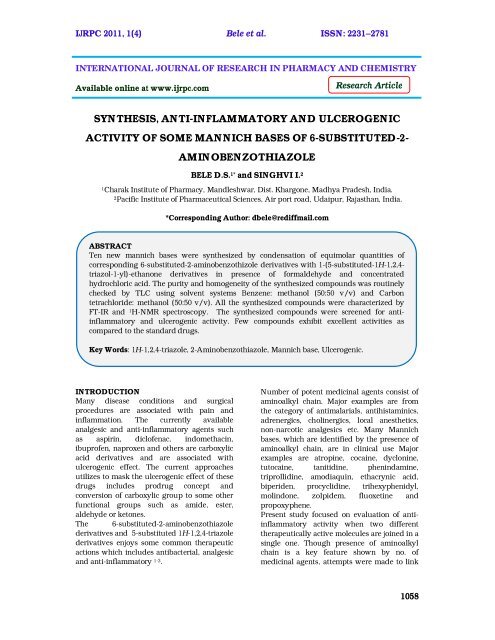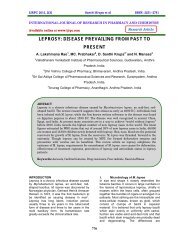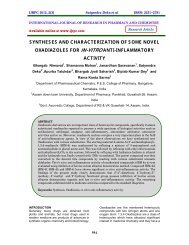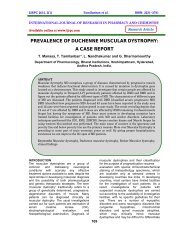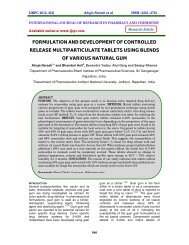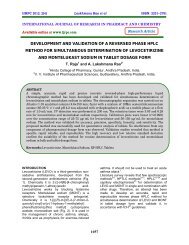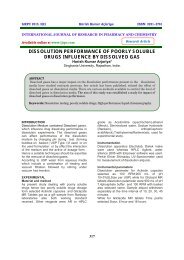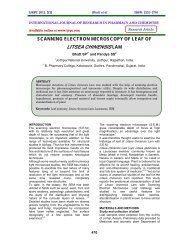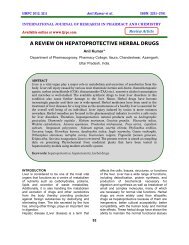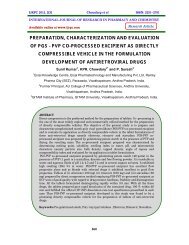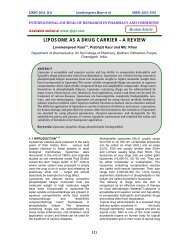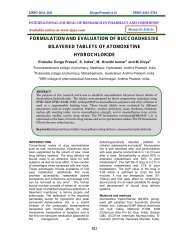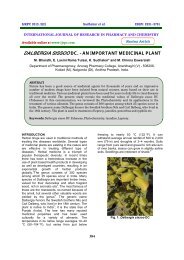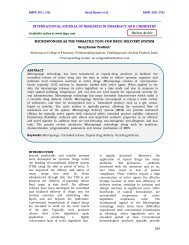synthesis, anti-inflammatory and ulcerogenic activity of some - ijrpc
synthesis, anti-inflammatory and ulcerogenic activity of some - ijrpc
synthesis, anti-inflammatory and ulcerogenic activity of some - ijrpc
Create successful ePaper yourself
Turn your PDF publications into a flip-book with our unique Google optimized e-Paper software.
IJRPC 2011, 1(4) Bele et al. ISSN: 22312781<br />
INTERNATIONAL JOURNAL OF RESEARCH IN PHARMACY AND CHEMISTRY<br />
Available online at www.<strong>ijrpc</strong>.com<br />
Research Article<br />
SYNTHESIS, ANTI-INFLAMMATORY AND ULCEROGENIC<br />
ACTIVITY OF SOME MANNICH BASES OF 6-SUBSTITUTED-2-<br />
AMINOBENZOTHIAZOLE<br />
BELE D.S. 1* <strong>and</strong> SINGHVI I. 2<br />
1 Charak Institute <strong>of</strong> Pharmacy, M<strong>and</strong>leshwar, Dist. Khargone, Madhya Pradesh, India.<br />
2 Pacific Institute <strong>of</strong> Pharmaceutical Sciences, Air port road, Udaipur, Rajasthan, India.<br />
*Corresponding Author: dbele@rediffmail.com<br />
ABSTRACT<br />
Ten new mannich bases were synthesized by condensation <strong>of</strong> equimolar qu<strong>anti</strong>ties <strong>of</strong><br />
corresponding 6-substituted-2-aminobenzothizole derivatives with 1-(5-substituted-1H-1,2,4-<br />
triazol-1-yl)-ethanone derivatives in presence <strong>of</strong> formaldehyde <strong>and</strong> concentrated<br />
hydrochloric acid. The purity <strong>and</strong> homogeneity <strong>of</strong> the synthesized compounds was routinely<br />
checked by TLC using solvent systems Benzene: methanol (50:50 v/v) <strong>and</strong> Carbon<br />
tetrachloride: methanol (50:50 v/v). All the synthesized compounds were characterized by<br />
FT-IR <strong>and</strong> 1 H-NMR spectroscopy. The synthesized compounds were screened for <strong>anti</strong><strong>inflammatory</strong><br />
<strong>and</strong> <strong>ulcerogenic</strong> <strong>activity</strong>. Few compounds exhibit excellent activities as<br />
compared to the st<strong>and</strong>ard drugs.<br />
Key Words: 1H-1,2,4-triazole, 2-Aminobenzothiazole, Mannich base, Ulcerogenic.<br />
INTRODUCTION<br />
Many disease conditions <strong>and</strong> surgical<br />
procedures are associated with pain <strong>and</strong><br />
inflammation. The currently available<br />
analgesic <strong>and</strong> <strong>anti</strong>-<strong>inflammatory</strong> agents such<br />
as aspirin, dicl<strong>of</strong>enac, indomethacin,<br />
ibupr<strong>of</strong>en, naproxen <strong>and</strong> others are carboxylic<br />
acid derivatives <strong>and</strong> are associated with<br />
<strong>ulcerogenic</strong> effect. The current approaches<br />
utilizes to mask the <strong>ulcerogenic</strong> effect <strong>of</strong> these<br />
drugs includes prodrug concept <strong>and</strong><br />
conversion <strong>of</strong> carboxylic group to <strong>some</strong> other<br />
functional groups such as amide, ester,<br />
aldehyde or ketones.<br />
The 6-substituted-2-aminobenzothiazole<br />
derivatives <strong>and</strong> 5-substituted 1H-1,2,4-triazole<br />
derivatives enjoys <strong>some</strong> common therapeutic<br />
actions which includes <strong>anti</strong>bacterial, analgesic<br />
<strong>and</strong> <strong>anti</strong>-<strong>inflammatory</strong> 1-3 .<br />
Number <strong>of</strong> potent medicinal agents consist <strong>of</strong><br />
aminoalkyl chain. Major examples are from<br />
the category <strong>of</strong> <strong>anti</strong>malarials, <strong>anti</strong>histaminics,<br />
adrenergics, cholinergics, local anesthetics,<br />
non-narcotic analgesics etc. Many Mannich<br />
bases, which are identified by the presence <strong>of</strong><br />
aminoalkyl chain, are in clinical use Major<br />
examples are atropine, cocaine, dyclonine,<br />
tutocaine, tanitidine, phenindamine,<br />
triprollidine, amodiaquin, ethacrynic acid,<br />
biperiden, procyclidine, trihexyphenidyl,<br />
molindone, zolpidem, fluoxetine <strong>and</strong><br />
propoxyphene.<br />
Present study focused on evaluation <strong>of</strong> <strong>anti</strong><strong>inflammatory</strong><br />
<strong>activity</strong> when two different<br />
therapeutically active molecules are joined in a<br />
single one. Though presence <strong>of</strong> aminoalkyl<br />
chain is a key feature shown by no. <strong>of</strong><br />
medicinal agents, attempts were made to link<br />
1058
IJRPC 2011, 1(4) Bele et al. ISSN: 22312781<br />
the benzothiazole <strong>and</strong> triazole ring via this<br />
chain with use <strong>of</strong> mannich reaction.<br />
For the compounds to acts as good analgesic,<br />
<strong>anti</strong>-<strong>inflammatory</strong> agent it should consist <strong>of</strong> a<br />
common structure i.e. Ar-NH-CH 2 -CH 2 -C-Ar<br />
which may consists <strong>of</strong> a secondary or tertiary<br />
nitrogen, a carbonyl carbon (whose none <strong>of</strong><br />
the valences are satisfied by hydrogen), an<br />
ethylene bridge between the basic nitrogen<br />
O<br />
<strong>and</strong> flat carbon (C=O) <strong>and</strong> aryl or heteroaryl<br />
ring substituents on nitrogen <strong>and</strong> carbonyl<br />
carbon 4,7 .<br />
From the consideration <strong>of</strong> the above factors it<br />
was planned to synthesize mannich bases <strong>of</strong> 6-<br />
substituted-2-aminobenzothiazole by carrying<br />
out reaction between 2-amino-benzothiazole,<br />
formaldehyde <strong>and</strong> 5-substituted-1H-1,2,4-<br />
triazole to results in molecules having the<br />
following structure:<br />
R<br />
4<br />
5<br />
N<br />
O<br />
3<br />
2'<br />
N<br />
NH-CH<br />
S<br />
2<br />
-CH 2<br />
-C<br />
2<br />
N<br />
6 7 1'<br />
1<br />
5'<br />
R<br />
3'<br />
N<br />
4'<br />
Though position 6- on 2-aminobenzothiazole<br />
<strong>and</strong> position 5- on 1H-1,2,4-triazole are most<br />
active, attempts were made to synthesize the<br />
derivatives that contains the substitute groups<br />
on both <strong>of</strong> this positions.<br />
MATERIAL AND METHODS<br />
The titled mannich bases were synthesized by<br />
mannich reaction between 6-substitued-2-<br />
aminobenzothiazole derivatives <strong>and</strong> 5-<br />
substituted-1H-1,2,4-triazol-1-yl-ethanone<br />
derivatives in presence <strong>of</strong> formaldehyde <strong>and</strong><br />
conc.HCl. The melting points <strong>of</strong> the<br />
synthesized compounds were determined on<br />
open capillary tubes <strong>and</strong> are uncorrected. The<br />
purity <strong>and</strong> homogeneity <strong>of</strong> the synthesized<br />
compounds was routinely ascertained by TLC<br />
using Benzene: Methanol (50:50 v/v) <strong>and</strong><br />
Carbon tetrachloride: Methanol (50:50 v/v) as<br />
solvents system. The absorption maxima <strong>of</strong> the<br />
synthesized compounds were carried out in<br />
methanol (analytical grade, 1mg/100mL). The<br />
methanolic solutions <strong>of</strong> the synthesized<br />
compounds were scanned on Shimadzu UV<br />
1700 spectrophotometer, Kyoto, Japan; in the<br />
region 200-400 nm. The infra red absorption<br />
spectra <strong>of</strong> the synthesized compounds were<br />
recorded using KBr disc on FTIR 8010<br />
Shimadzu model. The 1 H-NMR spectra <strong>of</strong> the<br />
synthesized compounds were recorded on<br />
Brucker Spectrospin DPX 300<br />
spectrophotometer. The solutions <strong>of</strong> the test<br />
compounds were prepared in dimethyl<br />
sulfoxide DMSO-d 6. Tetra Methyl Silane (TMS)<br />
was used as internal st<strong>and</strong>ard. Molecular<br />
weights <strong>of</strong> the synthesized compounds were<br />
determined by Rast’s camphor method. The<br />
analgesic <strong>activity</strong> <strong>of</strong> the synthesized<br />
compounds was evaluated by using hot plate<br />
method using Eddy’s hot plate. The <strong>anti</strong><strong>inflammatory</strong><br />
<strong>activity</strong> <strong>of</strong> the st<strong>and</strong>ard drug<br />
naproxen <strong>and</strong> synthesized compounds was<br />
determined against carrageenan induced acute<br />
paw edema in albino rats.<br />
RESULTS AND DISCUSSION<br />
A. SYNTHESIS 8-10<br />
The corresponding equimolar solutions <strong>of</strong> 6-<br />
substituted-2-aminobenzothiazole derivatives<br />
in methanol <strong>and</strong> 5-substituted-1H-1,2,4-<br />
triazol-1-yl ethanone derivatives in methanol<br />
were refluxed for around 3-5h in presence <strong>of</strong><br />
formaldehyde (used as formalin solution) <strong>and</strong><br />
concentrated HCl. The resultant mixtures were<br />
cooled at 0 0 C for about 24h to yield the<br />
mannich bases. Occasionally precipitation may<br />
be achieved by adding different solvents to the<br />
final reaction mixture. All the synthesized<br />
compounds were recrystallized with rectified<br />
spirit.<br />
6a<br />
3-(benzothiazol-2-yl-amino)-1-(1H-1,2,4-<br />
triazol-1- yl)-propan-1- one; white crystals,<br />
Yield 3.91 (43%), melting range 164 -6 0 C, Rf<br />
0.62, λ max 239.14 (methanol), IR (KBr, V max,<br />
cm -1 ): 3184 (NH), 3000 (-CH, Ar), 2675 (-CH 2-<br />
CH 2), 1618 (-C=O), 1236 (-C-N), 1H-NMR<br />
(DMSO-d6, δ ppm): 2.19-2.29(t, 2H, CH 2, α to<br />
NH), 3.70-3.77 (t, 2H, CH 2, α to –C=O), 4.17 (s,<br />
1H, NH), 7.60-7.70 (m, 4H, benzothiazole), 9.42<br />
1059
IJRPC 2011, 1(4) Bele et al. ISSN: 22312781<br />
(s, 1H, C-3’), 10.05 (s, 1H, C-5’), M= 271.5 (Th<br />
:273).<br />
6b<br />
3-(benzothiazol-2-yl-amino)-1-(5-methyl-1H-<br />
1,2,4-triazol-1- yl)- propan-1-one, white<br />
crystals, Yield 5.5g (57.41%), melting range 182<br />
-3 0 C, R f 0.84, λ max 235.1 (methanol), IR (KBr, V<br />
max, cm -1 ): 3300 (NH), 2985 (-CH, Ar), 2887 (-<br />
CH 2-CH 2), 1650 (-C=O), 1224 (-C-N),1458 (-<br />
CH 3), 1 H-NMR (DMSO-d6, δ ppm): 1.95 (s, 3H,<br />
C-5’-CH3)2.19-2.29(t, 2H, CH2, α to NH), 3.70-<br />
3.77 (t, 2H, CH2, α to –C=O), 4.17 (s, 1H, NH),<br />
7.60-7.70 (m, 4H, benzothiazole), 9.42 (s, 1H,<br />
C-3’) M= 284.9 (Th:287).<br />
6c<br />
3-(benzothiazol-2-yl-amino)-1-[5-(p-nitrophenyl)-1H-1,2,4-triazol-1-<br />
yl)-propan-1-one;<br />
yellow crystals, Yield 4.72g (36%), melting<br />
range 154 -6 0 C, R f 0.88, λ max 235.93 (methanol),<br />
IR (KBr, V max, cm -1 ): 3370 (NH), 3179 (-CH,<br />
Ar), 2964 (-CH2-CH2), 1680 (-C=O), 1284 (-C-<br />
N), 1 H-NMR (DMSO-d6, δ ppm): 3.70-3.77(t,<br />
2H, CH 2, α to NH), 3.97-4.03 (t, 2H, CH 2, α to –<br />
C=O), 4.55 (s, 1H, NH), 7.62-7.89 (m, 8H, Ar),<br />
9.42 (s, 1H, C-3’) M= 397.42 (Th:394).<br />
6d<br />
3-(benzothiazol-2-yl-amino)-1-[5-(p-methoxyphenyl)-1H-1,2,4-<br />
triazol-1- yl)-propan-1-one;<br />
black crystals, Yield 8.08g (64%), melting<br />
range164 -5 0 C, R f 0.91, λ max 293.14 (methanol),<br />
IR (KBr, V max, cm -1 ): 3462 (NH), 3179 (-CH,<br />
Ar), 2963 (-CH2-CH2), 1741 (-C=O), 1290 (-C-<br />
N), 1 H-NMR (DMSO-d6, δ ppm): 3.15 (s, 3H,<br />
C5’-Ar-OCH 3), 3.70-3.77 (t, 2H, CH 2, α to NH),<br />
3.97-4.03 (t, 2H, CH 2, α to –C=O), 4.60 (s, 1H,<br />
NH), 7.62-7.89 (m, 8H, Ar), 9.36 (s, 1H, C-3’)<br />
M= 376.25 (Th:379).<br />
6e<br />
3-(6-methoxy-benzothiazol-2-yl-amino)-1-<br />
(1H-1,2,4-triazol-1-yl)- propan-1-one, white<br />
crystals, Yield 3.86g (46%), melting range 208 -<br />
10 0 C, Rf 0.71, λ max 222.6 (methanol), IR (KBr, V<br />
max, cm -1 ): 3208 (NH), 2961 (-CH, Ar), 2872 (-<br />
CH 2-CH 2), 1718 (-C=O), 1458 (-CH 3), 1324 (-C-<br />
N), 1093(-OCH 3), 1H-NMR (DMSO-d6, δ<br />
ppm): 3.45-3.61 (t, 2H, CH 2, α to NH), 4.21-4.41<br />
(t, 2H, CH 2, α to –C=O), 4.49 (s, 3H, C6-OCH 3),<br />
4.54 (s, 1H, NH), 6.42-7.77 (m, 3H,<br />
Benzothiazole), 9.39 (s, 1H, C-3’), 10.05 (s, 1H,<br />
C-5’) M= 306.64 (Th:303).<br />
6f<br />
3-(6-methoxy-benzothiazol-2-yl-amino)-1-[5-<br />
(p-nitro-phenyl)-1H-1,2,4- triazol-1- yl)-<br />
propan-1-one, yellow crystals, Yield 3.64g<br />
(31%), melting range 209 -11 0 C, Rf 0.86, λ max<br />
252.34 (methanol), IR(KBr,V max, cm -1 ): 3200<br />
(NH), 3100 (-CH, Ar), 2983 (-CH 2-CH 2), 1718 (-<br />
C=O), 1458 (-CH 3), 1240 (-C-N), 1084 (-OCH 3),<br />
1H-NMR (DMSO-d6, δ ppm): 3.45-3.64(t, 2H,<br />
CH 2, α to NH), 4.21-4.41 (t, 2H, CH 2, α to –<br />
C=O), 4.49 (s, 3H, -OCH 3), 4.54 (s, 1H, NH),<br />
6.84-7.77 (m, 7H, Ar), 9.39 (s, 1H, C-3’) M=<br />
427.04 (Th:424).<br />
6g<br />
3-(6-methoxy-benzothiazol-2-yl-amino)-1-[5-<br />
(p-methoxy-phenyl)-1H-1,2,4- triazol-1- yl)-<br />
propan-1-one, white crystals, Yield 5.89g<br />
(52%), melting range 264 -5 0 C, R f 0.63, λ max<br />
232.15 (methanol), IR (KBr, V max, cm -1 ): 3200<br />
(NH), 3054 (-CH, Ar), 2841 (-CH 2-CH 2), 1630<br />
(-C=O), 1458 (-CH 3), 1240 (-C-N), 1093 (-<br />
OCH 3), 1 H-NMR (DMSO-d6, δ ppm): 3.16 (s,<br />
6H, C6-OCH 3 <strong>and</strong> C5’Ar-OCH 3), 3.45-3.64(t,<br />
2H, CH2, α to NH), 4.21-4.44 (t, 2H, CH2, α to –<br />
C=O), 4.54 (s, 1H, NH), 6.84-7.77 (m, 7H, Ar),<br />
9.42 (s, 1H, C-3’) M= 406.79 (Th:409).<br />
6h<br />
3-(6-chloro-benzothiazol-2-yl-amino)-1-[5-(pmethoxy-phenyl)-<br />
1H-1,2,4- triazol-1- yl)-<br />
propan-1-one, white crystals, Yield 3.8g (34%),<br />
melting range.247 -8 0 C, R f 0.68, λ max 217.0<br />
(methanol), IR (KBr, V max, cm -1 ): 3208 (NH),<br />
3049 (-CH, Ar), 2934(-CH 2-CH 2), 1718(-C=O),<br />
1356 (-C-N), 1263 (-OCH 3), 702 (C-Cl), 1 H-<br />
NMR (DMSO-d6, δ ppm): 2.51 (s, 3H, -OCH3),<br />
3.45-3.64 (t, 2H, CH2, α to NH), 4.21-4.41 (t, 2H,<br />
CH 2, α to –C=O), 4.54 (s, 1H, NH), 7.60-7.89<br />
(m, 7H, Ar), 9.42 (s, 1H, C-3’), M=<br />
412.11(Th:413.5)<br />
6i<br />
3-(6-nitro-benzothiazol-2-yl-amino)-1-(1H-<br />
1,2,4-triazol-1-yl)- propan-1-one, yellow<br />
crystals, Yield 2.85g (35%), melting range 264-<br />
5 0 C, R f 0.90, λ max 205.67 (methanol), IR (KBr, V<br />
max, cm -1 ): 3200 (NH),3100 (-CH, Ar), 2916 (-<br />
CH2-CH2), 1650 (-C=O), 1560 (C-NO2), 1224 (-<br />
C-N), 1 H-NMR (DMSO-d6, δ ppm): 3.70-3.77<br />
(t, 2H, CH 2, α to NH), 3.97-4.03 (t, 2H, CH 2, α<br />
to –C=O), 4.60 (s, 1H, NH), 7.62-7.73 (m, 3H,<br />
Benzothiazole), 9.39 (s, 1H, C-3’), 10.05 (s, 1H,<br />
C-5’) M= 315.5 (Th:318)<br />
1060
IJRPC 2011, 1(4) Bele et al. ISSN: 22312781<br />
6j<br />
3-(6-nitro-benzothiazol-2-yl-amino)-1-[5-(pnitro-phenyl)-1H<br />
1,2,4-triazol-1-yl]-propan-1-<br />
one, yellowish white crystals, Yield 4.16g<br />
(37%), melting range 266 -7 0 C, R f 0.68, λ max<br />
324.3 (methanol), IR (KBr, V max,cm -1 ):<br />
3268(NH), 3179 (-CH, Ar), 2963(-CH 2-CH 2),<br />
1643(-C=O), 1529 (-C-NO 2),1284 (-C-N), 1H-<br />
NMR (DMSO-d6, δ ppm): 3.45-3.64 (t, 2H,<br />
CH 2, α to NH), 4.21-4.41 (t, 2H, CH 2, α to –<br />
C=O), 4.49 (s, 1H, NH), 6.80-7.44 (m, 7H, Ar),<br />
8.90 (s, 1H, C-3’), M= 435.98 (Th:439).<br />
B. Biological <strong>activity</strong><br />
1. Anti-<strong>inflammatory</strong> <strong>activity</strong> 10-14<br />
The <strong>anti</strong>-<strong>inflammatory</strong> <strong>activity</strong> <strong>of</strong> the<br />
st<strong>and</strong>ard drug naproxen <strong>and</strong> synthesized<br />
compounds, (6a-j), was determined against<br />
carrageenan induced acute paw edema in<br />
albino rats (72 no. Weighing 200-225g). The 1%<br />
w/v solution <strong>of</strong> carrageenan for injection was<br />
prepared in normal saline (0.9% NaCl) <strong>and</strong> 0.1<br />
ml was injected underneath planter region.<br />
The dose, <strong>of</strong> st<strong>and</strong>ard drug <strong>and</strong> synthesized<br />
compounds, administered, in animals was 50<br />
mg/ kg, by oral route using oral feeding tube<br />
through tuberculin syringe. The stock<br />
suspensions <strong>of</strong> st<strong>and</strong>ard <strong>and</strong> synthesized<br />
compound were prepared in concentration <strong>of</strong><br />
10 mg/ml <strong>of</strong> 2% w/v CMC in distilled water.<br />
Results <strong>of</strong> <strong>anti</strong>-<strong>inflammatory</strong> <strong>activity</strong> are<br />
shown in Table 1, Table 2 <strong>and</strong> Graph 1.<br />
Compd. No.<br />
Table 1: Effect <strong>of</strong> the Test <strong>and</strong> St<strong>and</strong>ard compounds<br />
on carrageenan-induced rat paw Edema<br />
Dose<br />
(mg/kg, p.o)<br />
Increase in paw volume ( mean ± SEM) in ml at<br />
0h 0.5h 1.0h 2.0h<br />
Control<br />
(N/saline)<br />
2.5 ml/kg 0.0 0.83 ± 0.13 1.25 ± 0.13 1.73 ± 0.13<br />
6a 50 mg/kg 0.0 0.06 ± 0.13 0.36 ± 0.13 0.16 ± 0.13<br />
6b 50 mg/kg 0.0 0.65 ± 0.13 0.16 ± 0.13 0.13 ± 0.13<br />
6c 50 mg/kg 0.0 0.46 ± 0.14 0.28 ± 0.14 0.13 ± 0.13<br />
6d 50 mg/kg 0.0 1.46 ± 0.14 1.25 ± 0.14 1.48 ± 0.14<br />
6e 50 mg/kg 0.0 1.46 ± 0.13 1.95 ± 0.13 1.16 ± 0.13<br />
6f 50 mg/kg 0.0 1.63 ± 0.13 0.43 ± 0.13 0.11 ± 0.13<br />
6g 50 mg/kg 0.0 0.4 ± 0.13 0.11 ± 0.13 0.0 ± 0.13<br />
6h 50 mg/kg 0.0 1.5 ± 0.13 1.23 ± 0.14 0.6 ± 0.13<br />
6i 50 mg/kg 0.0 0.18 ± 0.14 0.51 ± 0.13 1.28 ± 0.13<br />
6j 50 mg/kg 0.0 0.63 ± 0.13 0.38 ± 0.13 0.28 ± 0.13<br />
Std. (Naproxen) 50 mg/kg 0.0 0.4 ± 0.14 0.2 ± 0.13 0.51 ± 0.14<br />
Table 2: Percentage inhibition <strong>of</strong> carrageenan induced rat<br />
paw edema, exhibited by the Test <strong>and</strong> St<strong>and</strong>ard compounds<br />
Compound<br />
No.<br />
% Inhibition <strong>of</strong> carageenan induced rat<br />
paw edema at<br />
0.5 h 1.0 h 2.0 h<br />
6a 92.77 71.2 90.75<br />
6b 21.68 87.2 92.48<br />
6c 44.57 77.6 92.48<br />
6d 0.0 0.0 14.45<br />
6e 0.0 0.0 32.94<br />
6f 0.0 65.6 93.64<br />
6g 51.80 91.2 100<br />
6h 0.0 1.6 65.31<br />
6i 78.31 59.2 26.01<br />
6j 24.09 69.6 83.81<br />
Std.<br />
(Naproxen)<br />
51.80 84.00 70.52<br />
1061
IJRPC 2011, 1(4) Bele et al. ISSN: 22312781<br />
%<br />
Ed<br />
e<br />
m<br />
a<br />
in<br />
hi<br />
120<br />
100<br />
80<br />
60<br />
40<br />
20<br />
0<br />
Comparison <strong>of</strong> % edema inhibition shown by the test <strong>and</strong><br />
st<strong>and</strong>ard compounds at 0.5, 1.0 <strong>and</strong><br />
2.0h<br />
6a 6b 6c 6d 6e 6f 6g 6h 6i 6j Std.<br />
0.5 h<br />
1.0 h<br />
2.0 h<br />
Graph 1: Comparison <strong>of</strong> % edema inhibition shown<br />
by the test <strong>and</strong> st<strong>and</strong>ard compounds at 0.5, 1.0 <strong>and</strong> 2.0 h.<br />
2. Ulcerogenic <strong>activity</strong> 15-17<br />
The Ulcerogenic <strong>activity</strong> <strong>of</strong> the st<strong>and</strong>ard drug<br />
naproxen <strong>and</strong> synthesized compounds 6(a-j)<br />
was determined by 14 days chronic studies<br />
using pyloric ligation-induced acid secretion<br />
<strong>and</strong> ulcer formation technique in albino rats.<br />
The procedure produces reliable number <strong>of</strong><br />
gastric ulcers. Diethyl ether (anesthetic ether)<br />
as inhalant was used as for anesthesia. The<br />
st<strong>and</strong>ard <strong>and</strong> test compounds were<br />
administered at dose <strong>of</strong> 50 mg/ kg 27 by oral<br />
route using oral feeding tube through<br />
tuberculin syringe. The stock suspension <strong>of</strong><br />
the st<strong>and</strong>ard <strong>and</strong> test compounds was <strong>and</strong><br />
prepared in concentration <strong>of</strong> 10 mg/ml <strong>of</strong> 2%<br />
w/v CMC in distilled water. The 0.01 N<br />
NaOH solution was used to determine acidity<br />
<strong>of</strong> gastric fluid using topfer’s reagent for free<br />
acidity <strong>and</strong> phenolphthalein indicator for total<br />
acidity. The gastric volume, acidity <strong>and</strong> ulcer<br />
index were compared for control <strong>and</strong> drug<br />
treated animals <strong>and</strong> are shown in Table 3,<br />
Graph 2 <strong>and</strong> Graph 3.<br />
Compound<br />
No.<br />
Table 3: Ulcerogenic pr<strong>of</strong>ile <strong>of</strong> the st<strong>and</strong>ard <strong>and</strong> test compounds<br />
Volume <strong>of</strong> gastric<br />
secretion (ml/100g)<br />
± SEM<br />
Ulcer<br />
Score<br />
Acidity <strong>of</strong> Gastric Secretion<br />
Free acidity ±<br />
SEM<br />
Total acidity ± SEM<br />
Control 1.90 ± 0.12 0 10.5 ± 0.20 43.0 ± 0.36<br />
6a 1.21 ± 0.12 0 9.96 ± 0.12 29.98 ± 0.12<br />
6b 1.37 ± 0.12 0.5 12.08 ± 0.12 45.28 ± 0.43<br />
6c 1.14 ± 0.12 0 9.88 ± 0.12 31.59 ± 0.48<br />
6d 1.45 ± 0.12 0 12.88 ± 0.31 48.14 ± 0.49<br />
6e 1.33 ± 0.12 0 12.41 ± 0.20 21.84 ± 0.35<br />
6f 1.57 ± 0.12 0 11.66 ± 0.12 35.80 ± 0.25<br />
6g 1.46 ± 0.12 0.5 13.23 ± 0.17 35.54 ± 0.34<br />
6h 1.76 ± 0.12 0 14.76 ± 0.35 37.66 ± 0.39<br />
6i 1.42 ± 0.12 0 12.89 ± 0.14 35.35 ± 0.38<br />
6j 1.36 ± 0.12 0 14.26 ± 0.19 37.13 ± 0.24<br />
Std. 2.46 ± 0.12 2 34.66 ± 0.41 73.33 ± 0.41<br />
1062
IJRPC 2011, 1(4) Bele et al. ISSN: 22312781<br />
40<br />
35<br />
g<br />
0<br />
30<br />
/1<br />
q<br />
25 e<br />
m<br />
20 ity<br />
id<br />
15 c<br />
a<br />
e<br />
10 re<br />
F<br />
5<br />
0<br />
.5<br />
0<br />
1<br />
6<br />
.9<br />
9<br />
8<br />
.0<br />
2<br />
1<br />
1 1.66 8<br />
.8<br />
9<br />
1 2.88 1 2.41 1 3.23 1 4.76 1 2.89 1 4.26 3 4.66<br />
CN 6a 6b 6c 6d 6e 6f 6g 6h 6i 6j Std.<br />
Compound No.<br />
CN<br />
6a<br />
6b<br />
6c<br />
6d<br />
6e<br />
6f<br />
6g<br />
6h<br />
6i<br />
6j<br />
Graph 2: Comparison <strong>of</strong> Free acidity<br />
80<br />
70 g<br />
0<br />
60<br />
/1<br />
q<br />
e<br />
50 m<br />
40 ity<br />
id<br />
c<br />
30 A<br />
l<br />
ta<br />
20 o<br />
T<br />
10<br />
0<br />
3<br />
4<br />
8<br />
.9<br />
9<br />
2<br />
8<br />
.2<br />
5<br />
4<br />
9<br />
.5<br />
1<br />
3<br />
4<br />
.1<br />
8<br />
4<br />
4<br />
.8<br />
1<br />
2<br />
CN 6a 6b 6c 6d 6e 6f 6g 6h 6i 6j Std.<br />
.8<br />
5<br />
3<br />
4<br />
.5<br />
5<br />
3<br />
Compound No.<br />
6<br />
.6<br />
7<br />
3<br />
5<br />
.3<br />
5<br />
3<br />
3<br />
.1<br />
7<br />
3<br />
3<br />
.3<br />
3<br />
7<br />
CN<br />
6a<br />
6b<br />
6c<br />
6d<br />
6e<br />
6f<br />
6g<br />
6h<br />
6i<br />
6j<br />
Graph 3: Comparison <strong>of</strong> Total Acidity<br />
CONCLUSION<br />
The determination <strong>of</strong> <strong>anti</strong>-<strong>inflammatory</strong><br />
<strong>activity</strong> inferred that compounds 6a, 6b, 6c<br />
<strong>and</strong> 6g possess more potent <strong>anti</strong>-<strong>inflammatory</strong><br />
<strong>activity</strong> than the st<strong>and</strong>ard drug. The <strong>activity</strong><br />
shown by these compounds is attributed to the<br />
presence <strong>of</strong> electron releasing groups on C6 <strong>of</strong><br />
Benzothiazole <strong>and</strong> C5 to triazole ring system.<br />
None <strong>of</strong> the tested compounds exhibited<br />
ulcerative effect as that was shown by the<br />
st<strong>and</strong>ard drug naproxen. Thus it can be<br />
assumed that the further exploration on this<br />
heterocycles may produce a good, yet devoid<br />
<strong>of</strong> ulcerative effect, <strong>anti</strong>-<strong>inflammatory</strong> agent.<br />
1063
IJRPC 2011, 1(4) Bele et al. ISSN: 22312781<br />
SYNTHETIC SCHEME<br />
S<br />
R<br />
N H 2<br />
p-su bs titute d A niline<br />
N H 4<br />
S C N<br />
c on c. HCl<br />
R<br />
N<br />
H<br />
C N H 2<br />
p-sub stitu ted P h enylth iou rea<br />
1(a-d )/1f<br />
Br 2 + C Cl 4<br />
N H 4<br />
O H<br />
R<br />
N<br />
S N H 2<br />
6-s ubs tituted-2-a m inob en zo thia zo le<br />
2(a -f)<br />
R - C O O H + H N - N H C 2<br />
H 5<br />
O H<br />
R - C O - N H - N H<br />
1 2 2<br />
1<br />
2<br />
s u b .C a r o b x y lic a c id H y d ra z in e<br />
s u b . A c id h y d r a z id e<br />
3 ( a - b )<br />
H C O N H 2<br />
O<br />
N<br />
N<br />
N R<br />
1<br />
C C H 3<br />
1 - ( 5 - s u b .-1 H -1 2 4 - tr ia z o l- 1 y l) -<br />
e th a n o n e<br />
5 (a -b )<br />
C H 3<br />
C O C l<br />
P yri di n e<br />
N<br />
N<br />
NH R1<br />
5 -s u b .-1 H - 1 2 4 - tr ia z o le<br />
4 ( a - b )<br />
2(a-f) + 5(a-b)<br />
HCHO<br />
conc.HCl<br />
4<br />
O 2'<br />
5<br />
N 3<br />
N 3'<br />
6<br />
N CH<br />
R<br />
S H 2<br />
CH 2<br />
C N<br />
7 1 2 1'<br />
N4'<br />
5'<br />
R 1<br />
3-(6-substituted-benzothiazol-2-yl-amino)-1-(5-substituted-1H-1,2,4-triazol-1-yl)-propan-1-one<br />
6 (a-j)<br />
1064
IJRPC 2011, 1(4) Bele et al. ISSN: 22312781<br />
REFERENCES<br />
1. Bradshaw TD. Brit J Cancer.<br />
2002;86,1348.<br />
2. Hutchinson I. J Med Chem. 2002;<br />
45:744.<br />
3. El-Sherbeny MA. Arzeneim-Forsh.<br />
2000;50:843.<br />
4. Racane L. Heterocycles. 2001;55:2085.<br />
5. Kashiyama E. J Med Chem.<br />
1992;42;4172.<br />
6. Shi DF. J Med Chem. 1996;39:3375.<br />
7. Bhusari SR, Pawar RP <strong>and</strong> Vibute YB.<br />
Indian J Heterocycl Chem. 2001;11:79.<br />
8. Sreenivasa MV, Nagappa AN <strong>and</strong><br />
Nargund LVG. Indian J Heterocycl<br />
Chem. 1998;8:23.<br />
9. Bhargava PN <strong>and</strong> Singh G. J Ind Chem<br />
Soc. 1961;3: 87.<br />
10. Parmar S. J Med Chem. 1972;15:999.<br />
11. Eddy NB <strong>and</strong> Leimbach DJ. J<br />
Pharmacol Expt Therap. 1953;107,<br />
385.<br />
12. Kulkarni SK. H<strong>and</strong>book <strong>of</strong><br />
Experimental Pharmacology, 3 rd Edn.<br />
Vallabh Prakashan, 1999;125.<br />
13. Ghosh MN.Evaluation <strong>of</strong> Analgesic<br />
Agents, Fundamentals <strong>of</strong><br />
Experimental Pharmacology, 2 nd Edn.<br />
Scientific Book Agency, Calcutta,<br />
1984.<br />
14. Winter CA. Proc Soc Exp Biol.<br />
1962;111: 544.<br />
15. Kulkarni SK. Arch Int Pharmacodyn.<br />
1986; 279: 324.<br />
16. Chakraborty A. Indian J Pharmacol.<br />
2004;36, 148.<br />
17. Katona. Clin Trials J. 1972; 8: 3.<br />
1065


